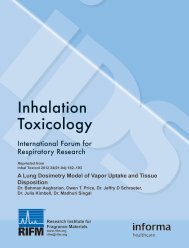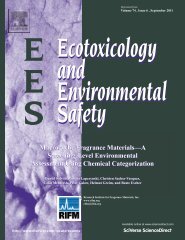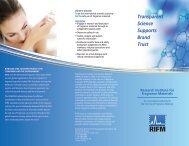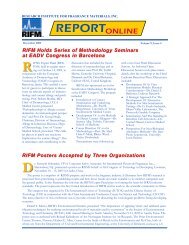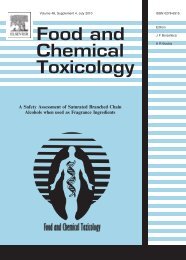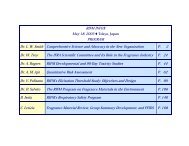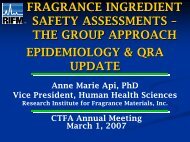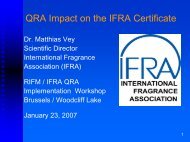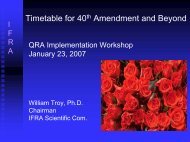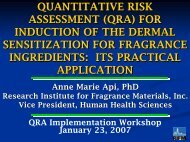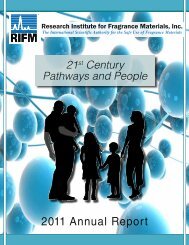It's My Space, Not Yours - Research Institute for Fragrance Materials
It's My Space, Not Yours - Research Institute for Fragrance Materials
It's My Space, Not Yours - Research Institute for Fragrance Materials
Create successful ePaper yourself
Turn your PDF publications into a flip-book with our unique Google optimized e-Paper software.
It’s <strong>My</strong> <strong>Space</strong>, <strong>Not</strong> <strong>Yours</strong>:<br />
Popular <strong>My</strong>ths, Scientific Realities &<br />
Public Perception<br />
Ladd W. Smith, PhD, Dipl. ABT, Fellow ATS, CAE<br />
President<br />
<strong>Research</strong> <strong>Institute</strong> <strong>for</strong> <strong>Fragrance</strong> <strong>Materials</strong>, Inc<br />
Scent World 2011<br />
December 8, 2011
Things you’ve heard<br />
• What is that?<br />
• Oh, that’s nice<br />
• Hmmm …<br />
• Yuck!<br />
• Let me tell you what I think about what<br />
you are doing<br />
• I don’t care … I already know<br />
• <strong>My</strong> perception outweighs your facts and<br />
logic<br />
• You’re just interested in selling product
Beholder’s perception<br />
An open mind is the best<br />
way to look at the world.
Little disagreement …
One solution …
Another solution …
Disagreement ...
Disagreement?
Pleasure vs. pollution?
What is “scent?”<br />
wikipedia<br />
• An odor is caused by one or more volatilized<br />
chemical compounds, generally at a very low<br />
concentration, that humans or other animals<br />
perceive by the sense of olfaction<br />
• Odors are also commonly called scents, which can<br />
refer to both pleasant and unpleasant odors<br />
• The terms fragrance, scent, and aroma are used<br />
primarily by the food and cosmetic industry to<br />
describe a pleasant odor, and are sometimes used<br />
to refer to perfumes<br />
• In contrast, malodor, stench, reek, and stink are<br />
used specifically to describe unpleasant odors
Blogs, Sept 2011<br />
• <strong>Fragrance</strong> is a very personal choice, I<br />
cannot see any way that someone else<br />
can tell me what I will or will not like.<br />
• Agreed. In my house my wife does have<br />
great influence on what fragrance I use<br />
based on her likes/dislikes. She respects<br />
my opinion as well when it comes to her<br />
choice of fragrances <strong>for</strong> her use.
Neural mechanism supports<br />
survival in an uncertain world<br />
Wednesday, June 10, 2009 - 12:44 in Psychology & Sociology<br />
• A new study uncovers a pivotal role <strong>for</strong> the<br />
human frontal lobe in the promotion of<br />
behavioral flexibility during voluntary<br />
choice. The work, published by Cell Press in<br />
the June 11th issue of the journal Neuron,<br />
presents a critical new neural mechanism<br />
that supports the decision to adapt or<br />
maintain behavior when change is not<br />
explicitly instructed by the external<br />
environment.
More about choice …<br />
Frontiers <strong>Research</strong> Topic on The Neurobiology of Choice<br />
Julia Trommershaeuser , , 2011, Center <strong>for</strong> Neural Science, New York Univ<br />
“<strong>Research</strong> on economic decision-making seeks to<br />
understand how subjects choose between plans of<br />
action (lotteries, gambles, prospects) that have<br />
economic consequences. The key difficulty in<br />
making such decisions is that typically no plan of<br />
action available to the decision-maker guarantees a<br />
specific outcome, rather, consequences are risky or<br />
uncertain. … Moreover, researchers across all these<br />
fields are, in parallel, studying how decisions are<br />
guided by learning and how the computations<br />
relevant to decisions and choices are represented<br />
neurally.”
Can you tolerate this?
Frustration …
Confined space or worse?
Involuntary “exposure”
Headache is common complaint …
The brain is complicated
Still a lot we don’t know
People influence what we<br />
perceive and believe
Clinical research<br />
• Dr. Pamela Dalton, Monell, 1996<br />
• “The influence of cognitive bias on the<br />
perceived odor, irritation and health<br />
symptoms from chemical exposure”<br />
• The results provide strong evidence<br />
that both the perceived odor and<br />
cognitive expectations about a chemical<br />
can significantly affect how individuals<br />
respond to it.
Positive or negative …
OMG, “XYZ” is a VOC!
So is silage
So is body odor
So is an onion
Guilt by association …<br />
• I smell something<br />
• I have a “problem” (irritation, sensitivity,<br />
headache, rash, etc)<br />
• There<strong>for</strong>e, the smell (your product)<br />
caused my problem
An “argument”<br />
Dartmouth Writing Program<br />
A good argument will have, at the very least:<br />
• a thesis that declares the writer's position on<br />
the problem at hand<br />
• an acknowledgment of the opposition that nods<br />
to, or quibbles with other points of view<br />
• a set of clearly defined premises that illustrate<br />
the argument's line of reasoning<br />
• evidence that validates the argument's<br />
premises<br />
• a conclusion that convinces the reader that the<br />
argument has been soundly and persuasively<br />
made
Is the argument logical?<br />
A syllogism is made up of three statements<br />
• the major premise, or general<br />
observation<br />
• the minor premise, or particular<br />
observation<br />
• the conclusion, which is something that<br />
one might rightly deduce from the<br />
premises given
One syllogism<br />
• All scientists are brilliant<br />
• I am a scientist<br />
• There<strong>for</strong>e, I am brilliant<br />
But, the first statement, the major<br />
premise, is not true.
Another syllogism<br />
• Everyone who has taken the preparatory<br />
course has passed the exam<br />
• John Q. has taken the course<br />
• There<strong>for</strong>e, John Q. will pass the exam<br />
The major premise is true.<br />
Could John be the first exception?
Validating the argument<br />
• Have you suppressed any facts?<br />
• Have you manipulated any facts?<br />
• Do you have enough evidence?<br />
• Do you have too much evidence?<br />
• Is your evidence current, reputable?
Respiratory research objective<br />
To understand the physiological effects<br />
of exposure to fragrance materials upon<br />
inhalation from a consumer product,<br />
when that product is used as intended
Cilia and mucociliary<br />
escalator<br />
Oropharynx<br />
to main<br />
bronchi<br />
Airways<br />
Alveolarcapillary<br />
membrane<br />
CONFIDENTIAL MS IFRA NA 11.2011
Program structure<br />
EXPOSURE<br />
BIOAVAILABILITY<br />
WHERE DOES THE<br />
MATERIAL GO UPON<br />
INHALATION?<br />
PROTEIN<br />
REACTIVITY<br />
IMMUNE SYSTEM<br />
STIMULATION<br />
CLINICAL<br />
RESPONSE<br />
WHAT DOES THE MATERIAL<br />
DO IN THE RESPIRATORY<br />
SYSTEM?<br />
WHAT EFFECT DOES THE<br />
MATERIAL INTERACTION<br />
WITH THE AIRWAY HAVE?
2-Box model scenario
Air dispersion model output<br />
Concentration (mg/m 3 )<br />
Peak Air Concentration in<br />
Room of Interest (bathroom,<br />
bedroom, living room, etc.)<br />
Peak Air Concentration in the<br />
Rest of the House<br />
Risk Assessment Tool<br />
<strong>for</strong> Application to:<br />
• Fine <strong>Fragrance</strong> Spray<br />
• Aerosol Air Care<br />
• Scented Candles<br />
• Incense<br />
• Reed Diffusers<br />
• Heated Oil Plug-In<br />
Time (min)
Alternate 2-box scenario<br />
(Nearfield/Farfield analysis)
Upper airway deposition model
In Vivo corroboration<br />
• OECD 412-based pilot in vivo inhalation<br />
study completed successfully<br />
– Laboratories competent and produced<br />
reproducible, reliable data <strong>for</strong> all endpoints<br />
evaluated<br />
• <strong>Materials</strong> identified <strong>for</strong> 2011-2012 testing<br />
– <strong>Materials</strong> procured and on site<br />
– Studies underway<br />
– Dosimetry Subgroup reviews all data and dose<br />
recommendations
Cellular cytokine profiling<br />
• Triple co-culture air-liquid system<br />
• <strong>Materials</strong> can be delivered as an<br />
aerosol, gas, or insoluble particulate<br />
<strong>for</strong>ms at a set flow rate and<br />
concentration (identify dose/unit area)<br />
• Cross-talk between cell types can be<br />
studied without overt destruction of<br />
cellular structures<br />
• Cytokine profiles to be evaluated by<br />
multi-analyte flow cytometry and ELISA<br />
targeting distinction in cytokine<br />
expression patterns between respiratory<br />
irritants and respiratory sensitizers
Dendritic cells identified<br />
(CD86/DAPI)
Macrophages identified<br />
(CD14/DAPI)
Type II epithelial cells identified<br />
(SP-C/DAPI)
Cytokines of interest<br />
• Successful pilot study<br />
– Macrophage Inflammatory Protein (MIP)-2<br />
– RANTES<br />
– Interferon (IFN)-γ<br />
– Interleukin (IL)-1β<br />
– IL-4<br />
– Intracellular Adhesion Molecule (ICAM)-1<br />
– IL-5<br />
– IL-10<br />
– IL-13<br />
– Tumor Necrosis Factor (TNF)-α<br />
– Trans<strong>for</strong>ming Growth Factor (TGF)-β<br />
– Macrophage Chemotactic Protein (MCP)-1
Lady gaga to rock out Times<br />
Square on News Year’s Eve
Who is this, a scientist?
Point …<br />
The incoming president of the American<br />
College of Asthma Allergy and Immunology<br />
(ACAAI) - Dr. Stanley Fineman - gave a talk at<br />
the ACAAI’s recent annual meeting<br />
implicating use of air fresheners in the<br />
increasing rates of asthma and allergies. The<br />
ACAAI issued a press release on Dr.<br />
Fineman’s talk, which has been picked up by<br />
several media outlets, including msnbc.com<br />
and USA Today, among others.
Counterpoint …<br />
Consumers can be assured that the<br />
fragranced air fresheners they use in their<br />
homes are safe … There is no definitive<br />
scientific evidence, clinical or otherwise,<br />
to prove that fragrance materials cause<br />
asthma, nasal congestion, sneezing, or<br />
runny nose … it is irresponsible to assign<br />
blame to popular consumer products<br />
without supporting scientific evidence.
Counterpoint …<br />
The safety of fragrances marketed today is<br />
based on clinically proven, scientific<br />
studies reviewed by an independent panel<br />
of experts, published in the highest level,<br />
peer-reviewed, scientific journals available<br />
to anyone … The fragrance industry<br />
welcomes scientific dialogue, but insists<br />
on real science and fact-based consumer<br />
education and medical advice.
Industry guidance
“Maximum impact<br />
with minimum downside”
Also: Maximum impact<br />
with minimum downside<br />
Don't Be Victimized By Variable Annuities<br />
www.expertlaw.com/library/finance/variable<br />
_annuities.html<br />
Cached - Similar<br />
<strong>Not</strong> helpful? You can block<br />
www.expertlaw.com results when you're<br />
signed in to search.www.expertlaw.com<br />
Block all www.expertlaw.com results
Scent intensity … 1<br />
Crater Lake Company<br />
We have added a Very Strong option in our scent intensity<br />
menu, but feel that in most cases, selecting the Medium to<br />
Strong intensity is adequate. With that said, if you choose to<br />
have your products very strongly scented, please be advised<br />
that:<br />
• A. By doing so may cause skin irritation. In almost ALL cases,<br />
we find that the Medium to Strong scent intensity option is<br />
adequate. By choosing the Very Strong scent intensity, you<br />
acknowledge that you are aware of the possible skin<br />
irritations that this may cause.<br />
• B. We do not recommend Very Strong scent intensities <strong>for</strong><br />
spice and citrus based fragrances as this may cause an<br />
irritation. Keep in mind that these scents are naturally strong<br />
to begin with and recommend a medium intensity <strong>for</strong><br />
fragrances in the spice and citrus family.
Scent intensity … 2<br />
Crater Lake Company<br />
• C. Some scents are naturally light regardless of the<br />
proportion of fragrance oil we use in the product.<br />
Choosing Very Strong <strong>for</strong> naturally light scents does<br />
not make the fragrance any more apparent than<br />
choosing the recommended medium to strong scent<br />
intensity. This may also compromise the product's<br />
stability as the oils and butter ratios are pretty closely<br />
calibrated.<br />
• D. Choosing the Very Strong scent intensity option<br />
may change the viscosity of our shower gels and<br />
shampoos. Depending on the fragrance oil, it may<br />
cause the base to become either more fluid or thick.
Scent intensity … 3<br />
• E. We reserve the right to decrease the scent<br />
intensity requested if we believe it is in your best<br />
interest. Since we have a good knowledge of the<br />
scents we carry and their characteristics, there may<br />
be times where I’ll make a judgment call on a<br />
particular scent. If I do, I will try to contact you first<br />
and consult with you regarding the matter.
Scent intensity … 4<br />
Crater Lake Company<br />
All intensity levels are within safe usage guidelines, however<br />
scent intensity is not an exact science. Within the<br />
recommended guidelines, there are no fixed percentages of<br />
fragrance oil usage. Asking us to super-scent something<br />
doesn't mean we pour half the bottle of fragrance oil into<br />
the base! Scent intensity <strong>for</strong>mulation takes the fragrance oil's<br />
natural characteristics to determine the correct percentage<br />
amount to use in the specific product to ensure that its<br />
integrity and stability is not compromised. For example, a 2%<br />
fragrance oil load using a vanilla-based scent may be<br />
characterized as being Light, whereas the same percentage<br />
load using a spice-based scent may be deemed Strong.
Intensity, compound ratios,<br />
snapdragons, honeybees<br />
Wright, Lutmerding, Dudareva, Smith, 2005<br />
Floral scent is used by pollinators during<br />
<strong>for</strong>aging to identify and discriminate among<br />
flowers … The ability to discriminate among<br />
scents may depend on both scent intensity<br />
and the ratios of the concentrations of the<br />
volatile compounds of a complex mixture<br />
rather than on the presence of a few<br />
compounds … The ability of honeybees to<br />
discriminate among the scents of different<br />
cultivars was a function of the intensity of the<br />
floral scent.
Emily, at a conference …<br />
“Also, we spoke about your research and<br />
you were laughing at my fear of<br />
fragrances. I would love to understand<br />
more about what you do and if it means<br />
it’s safe to buy febreeze (sic)!”
“You can check out any time you<br />
like, but you can never leave”
Dear Emily … 1<br />
• The article, in the link below, notes the difference<br />
between irritants and allergens and in<strong>for</strong>ms people<br />
that the allergy-like symptoms they may be<br />
experiencing may not be an allergy at all. One item of<br />
interest is that the first irritant noted on the list is<br />
“perfumes and other substances with strong odors.”<br />
http://www.usatoday.com/news/health/painter/2010-<br />
08-23-yourhealth23_ST_N.htm<br />
• Here is a good, unbiased website that you may want<br />
to consult <strong>for</strong> general science issues.<br />
http://www.senseaboutscience.org.uk/<br />
• This one tends to look at scientific “crises,” and tries<br />
to provide perspective. http://www.acsh.org/
Dear Emily … 2<br />
• Here is one about “chemicals.” Many people don’t realize<br />
that everything is a chemical, even a rock. The “cool<br />
science” and “everyday chemistry” tabs are<br />
instructive. http://portal.acs.org/portal/acs/corg/content<br />
• This one looks at natural vs. synthetic. It is easy to find<br />
statements about the relative safety of “natural” products,<br />
but remember that Mother Nature built her plants and<br />
animals to survive. So they have innate protection<br />
mechanisms. Some are mechanical things like prickles,<br />
while some are chemical toxins. I can tell you I have a<br />
healthy respect <strong>for</strong> bees, since I am allergic to them and<br />
have had a few “too close” calls at the ER.<br />
http://drholly.typepad.com/natural_vs_synthetic/
Dear Emily … 3<br />
• You and your family should not be afraid of<br />
exposure to chemicals, natural or synthetic, any<br />
more than you should be afraid of crossing the<br />
street – because you can exercise judgment in<br />
what you do.<br />
• You mentioned Febreze, so I found this<br />
citation. You can find others easily by searching,<br />
or you can call the manufacturer directly – in<br />
this case it is Procter & Gamble.<br />
http://www.gooddogmagazine.com/how_safe_i<br />
s_febreze.htm
There is still a lot we don’t know



